The thing about these reviews is that they are, on the surface at least, about the best brands in a given product category. However, we like for our readers to walk away with a lot more than just a knowledge of the best brands in a given product category. How can you truly appreciate what is best in a given collection if you do not have intimate knowledge of the things in that category. If we’re going to talk about fuel transfer pumps, then we will go deep. We will talk about everything you need to know about fuel transfer pumps. We will give you an in-depth introduction to the subject. By the time we’re reviewing the subjects, you’ll feel like a pro who knows exactly what he’s looking for and can spot it from a mile away. Here we shall have a brief introduction to fuel transfer pumps and give and overview of the most important points. Then, after the reviews, we’ll go even deeper and turn you into a fuel transfer pump pro.
- Features to consider in Good Fuel Transfer Pumps
- Top 10 Best Fuel Transfer Pumps 2025
- 1. Fill-Rite FR1210G Fuel Transfer Pump
- 2. FuelWorks Electric Fuel Transfer Pump Kit
- 3. ARKSEN Fuel Transfer Pump
- 4. GoPlus Electric Diesel Fuel Transfer Pump
- 5. Self-Prime Oil Transfer Pump
- 6. Fill-Rite FR1614 Diesel Fuel Transfer Pump With Hoses
- 7. FuelWorks 10305708A 12V 15GPM Fuel Transfer Pump Kit
- 8. XtremePowerUS X1114
- 9. Koehler Enterprises RA990
- 10. TeraPump TRFA01
- Guide to Buying the Best Fuel Transfer Pumps
Features to consider in Good Fuel Transfer Pumps
What, exactly, is a Fuel Transfer Pump?
The name should give it all away at this point. A fuel transfer pump is designed to carry out one job, which the majority of them do very well: it is designed to transfer fuel from one point to another. In this case, it draws the fuel from a major source, such as an underground tank, and transfers it to a vehicle, or a piece of equipment that runs on fuel.
A fuel transfer device combines both mechanical and electrical parts and takes advantage of high pressure to suck fuel out of its source and deliver it to a destination. That said, a fuel transfer pump can be used for various purposes, including refueling vehicles, machinery, and equipment on construction sites.
What Types of Fuel Transfer Pumps are out there?
The simple answer is that there are many types of fuel transfer pumps out there, depending on the methods by which you categorize them. If we look at how they are powered, then there are 3 types of fuel transfer pumps:
- Manual Fuel Transfer Pumps – These pumps are the cheapest of the bunch. That, however, comes at a price because you have to operate the pump manually in order to transfer the fuel. That means it needs a lot of elbow grease and will be the most difficult type of pump to operate. These pumps typically come with hand pumps which you rotate in order to get the pump to suck fuel out of its source.
- Electric Fuel Transfer Pumps – These pumps are a lot easier to operate than manual fuel transfer pumps. They may use either alternating current or direct current to operate the pump. If the pump uses direct current, then it has the advantage of being portable since it can be powered by a battery or an engine. As a result of their utility, these pumps are more expensive than manual fuel transfer pumps. The most common characteristic of electric fuel transfer pumps is the fact that they are explosion proof as they come with a very tough encasing.
- Engine Powered Fuel Transfer Pumps – These pumps are coupled with an engine, which is their source of power. They have something called an impeller shaft, which is connected to the propeller shaft in the engine. As the propeller shaft rotates, it powers the impeller shaft which in turn operates the pump and causes it to suck up fuel from the source. Most engine powered fuel transfer pumps come with a centrifugal pump for the drawing of fuel.
Apart from that, there are other ways to categorize fuel transfer pumps, such as the speed at which fuel flow in them. This is called the flow rate of the pump. If we categorize fuel transfer pumps according to their flow rate then there are also 3 types of such pumps:
- Low Speed Fuel Transfer Pumps – These pumps are the slowest, as you might have guessed. The speed in such pumps is typically 50 liters per second. Don’t be fooled by the fact that they are the slowest, however, as they are more than enough for transferring fuel to most small vehicles.
- Medium Speed Fuel Transfer Pumps – This type of pump is intermediate in speed and pumps fuel at a rate of about 70 liters per minute It is an excellent speed for service vehicles and medium to large vans.
- High Speed Fuel Transfer Pumps – This type of pump, as you might have guessed from the name, is the fastest of the three. It will pump fuel at a rate of about 90 liters per minute. That is the perfect speed for large vehicles, such as trucks and buses, and heavy construction machinery and equipment.
The idea, when it comes to the flow rate, is that we want a fuel transfer pump that will fill the tank of the destination as fast as possible. Since larger fuel and equipment have larger tanks, they need fuel transfer pumps with higher flow rates.
Factors to Consider when purchasing a Fuel Transfer Pump
When looking at various pumps, you will want to be able to weigh the pros and cons of each in order to make a better decision. Here is a brief overview of some of the things you should consider:
- The intended purpose of the pump – What are you going to use the pump for? If you’re using it for something simple, such as fueling small vehicles, then just about any model will do. For larger vehicles, machinery, and equipment, you will need a powerful pump.
- The type of fuel you’re pumping – Some models are built only for diesel while others will handle diesels, gasoline, kerosene, and oil. If you’re going to be pumping different types of fuel, go for a versatile pump.
- How easy the pump is to use – Right from installing the pump to operating it, the ease of use is an important consideration when making a decision about which fuel pump to purchase. Go for one that is user friendly, with a comprehensive instruction manual and that comes with everything you will need for the assembly and installation process.
- How durable the pump is – The materials used, as well as the overall construction of the fuel transfer pump should be of good quality and will be an indicator of the longevity of the pump. The pump, nozzle, and case should all be inspected to determine if they can withstand wear and tear.
- The voltage of the pump – This is another important technical specification that you cannot overlook. The voltage input of the pump should perfectly match the voltage output of the power source or the product may not work as expected.
- Safety issues – The pump should be designed to maximize safety. That means it should be explosion proof and have passed all quality control tests, ensuring you have peace of mind while operating it.
- The warranty on the pump – The warranty on fuel transfer pumps is typically about a year. However, depending on the policies of the manufacturer and the quality of the product, it can be longer. Warranties usually include the repair and replacement of any damaged parts. Don’t go for any fuel transfer pump with a warranty of less than one year.
- Reviews of the pump – This is best when you’ve looked at every other factor and still can’t make our mind up. In that case, it might be a good idea to seek out the opinions of others. The best way to do this is read an online review, such as the one you are reading right now. That way, you’ll get a more detailed look at the pros and cons of the different products.
Top 10 Best Fuel Transfer Pumps 2025
1. Fill-Rite FR1210G Fuel Transfer Pump
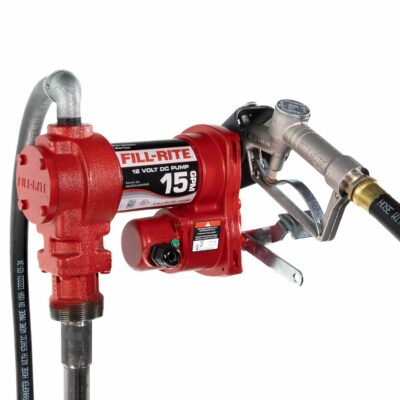
Editor’s Rating:
Design
This fuel pump is about as good as it gets, powered by a 20 ampere DC motor with a quarter horsepower. A quarter horsepower may sound like precious little when you compare it to the hundreds you get with vehicles, but believe us when we tell you that this device delivers some serious raw power. For that reason, it is known to be very loud when compared to competitors in the market.
The pump is also very versatile, being able to pump diesel, gasoline, and kerosene. For that reason alone, it is an absolute favorite among buyers. It is also extremely durable for both the construction and the materials used to construct it. The pump itself is made out of heavy duty cast iron, which virtually guarantees that it will last a lifetime, even if the pump’s internal parts fail. But don’t worry, they won’t. The internal construction is also top of the line. We know that because of the numerous safety and quality certifications that the pump has. With great parts, a durable casing, and plenty of safety certifications, including being explosion proof, it’s pretty difficult to beat this product. That’s why the pump has become something of a trend setter in the industry.
Performance
Since it is powered by DC, the operation is a lot smoother than that of a pump that is operated by AC, and it is possible to connect the pump to some heavy duty batteries in order to operate it, or a generator. It also comes in with a built-in strainer to ensure the fuel going through is only of the cleanest quality.
Finally, it comes with a 2 year warranty, which means you’re going to have some peace of mind while you operate it.
Pros
- Very durable construction
- Comes with a built-in strainer to ensure you get clean fuel
- Has numerous versatile applications
Cons
- Does not come with an anti-siphon valve
2. FuelWorks Electric Fuel Transfer Pump Kit
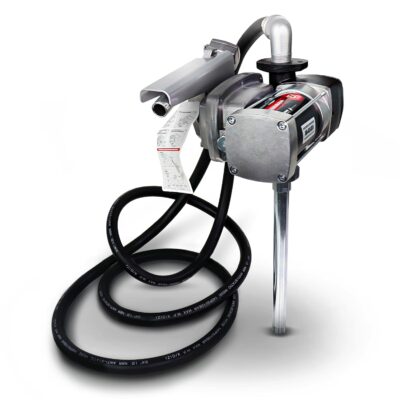
Editor’s Rating:
Design
You might be surprised about why this fuel transfer pump ranks so highly on this list once you learn that is only used to pump diesel and happens to be pretty small. However, despite the fact that it only pumps diesel, and its size, this pump delivers in a very big way when it comes to performance. It does so well, in fact, that we are sad that it doesn’t work for gasoline and kerosene. That’s how good it is.
The other thing we absolutely love about this fuel transfer pump is the fact that you can easily adjust it. That means it is highly customizable and can be made fit for just about any purpose that you could envision. The hose can be adjusted to pretty much any length. That means that whatever the typical distance between your fuel source and its destination, you can customize the pump to accommodate it.
Performance and Special Hose Feature
The hose itself is 13 feet long upon purchase. If you have uses for the pump where the hose doesn’t need to constantly be at its full length, then you might have issues keeping it in one place. That’s why it might make more sense to just cut the hose and have it at the length you need for the application you intend to use the pump. It’s still a pretty useful hose with a nozzle right at the end, which you use to dispense the fuel.
If you think that is the deal of a lifetime, then you will be impressed by the fact that this pump also has a self-printing feature. That makes it an excellent choice for commercial use. The electric motor that comes with it also has IP55 classification, making it both powerful and durable. It’s just hard to go wrong with this pump.
Pros
- It has a thermal protection switch
- It is very user friendly
- It is adjustable
Cons
- Only works for diesel
3. ARKSEN Fuel Transfer Pump
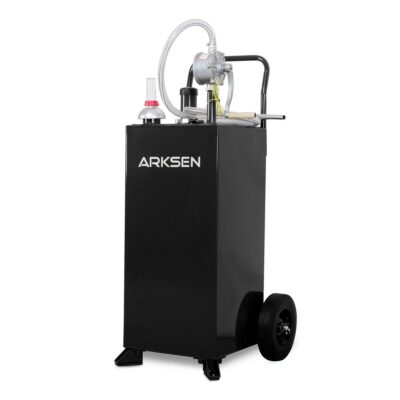
Editor’s Rating:
Design
This fuel transfer pump operates on 12 volts and comes with a quarter horsepower. The motor itself is 22 amperes. Now, some of these figures might seem quite small when we’re talking about power, but don’t get it wrong; in the world of fuel transfer pumps, that is a lot of power to deal with. A quarter horsepower means a flow rate of 20 gallons a minute, which is over 50 liters a minute, and the wattage that comes from that motor is over 260 watts. It’s quite respectable.
Performance
That’s the power out of the way, but what if what you’re looking for a highly versatile pump? In that case, you should look no further than this pump. The technical specs of this fuel transfer pump say it can be used for a whole range of petroleum products, including diesel, gasoline, kerosene, mineral spirits, hexane, and heptane. That’s basically a pump that you can use to transfer just about everything. If you have a commercial setting where you need a versatile pump for all your products, or just happen to deal with a lot of petroleum products on a daily basis, then you should get yourself this pump as soon as you can.
There are also lots of safety features that come with this pump. The process of transferring fuel needs to be perfectly safe for it to be perfectly smooth, and that’s why it’s important that any pump you buy come with the right safety features for you. That said, this pump, first and foremost, has a very robust construction that is able to resist explosion. It also has protection against extreme temperature conditions, making it highly resistant in tough environments.
The casing of the pump itself is the highly reliable cast iron. Cast iron is commonly used to manufacture casings for the highest quality fuel transfer pumps because of its strength and durability. It is capable of providing your fuel transfer pump with all the protection it will ever need from explosion, wear, and tear, from a variety of environmental factors.
Pros
- Great pump quality
- It has a very good flow rate and will transfer your fuel at very high speeds
- It can be installed in a very short time due to its user friendly nature
Cons
- It tends to be noisier that its competitors
4. GoPlus Electric Diesel Fuel Transfer Pump
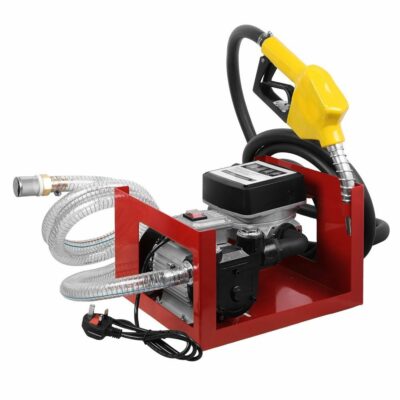
Editor’s Rating:
Design
In the world of fuel transfer pumps the technical specifications concerning the voltage can vary wildly between pumps, and that is why it is important that you check the voltage of a pump before you purchase it, just to make sure it is compatible with your intended power source, otherwise you might buy a really good pump, only to get it home and realize that you can’t operate it because of incompatibilities in the voltage.
Performance
That said, the motor on this pump has a voltage of 110V, which means you will need to find a power source that can deliver that much voltage. It is also capable of delivering fuel at a flow rate of about 16 gallons per minute, which translates to about 50 liters per minute. For most regular purposes, this pump is an excellent choice. And it’s pretty efficient too!
Efficiency isn’t the only perk you get with this pump, however. Durability is something you can expect as well. To begin with, the pump itself is anything but fragile, being made of the highest quality heavy duty iron. Granted, that makes it a bit heavier than your average fuel transfer pump, but it also means that what you have is robust and will withstand just about anything. It also means the pump is perfectly durable.
The pump itself is a rotary vane pump and is self-priming. That means it will transfer your fuel in an effortless and efficient manner. The installation is also just as effortless. Due to the user friendliness of the pump and its comprehensive user’s manual, you can complete the installation in a snap with needing any help from a professional.
Pros
- It is compatible with both manual and automatic nozzles
- It has a self-priming rotary vane pump
- It has a very durable construction
Cons
- It only works for diesel
5. Self-Prime Oil Transfer Pump
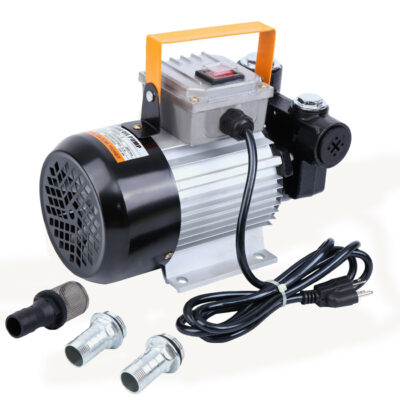
Editor’s Rating:
Design
Sometimes, you don’t need a product with all the bells and whistles that come with products in its category. You don’t want the one brand that makes everyone turn their head and gets you a ton of compliments about how great your product looks or how it’s a cut above the rest. Sometimes, all you need is something that does the job it was intended for, and does it perfectly at that. You don’t want all the extras they tack on or any of the sleek designs that make it look like you’re carrying something futuristic. If that’s what you want, then this is one of those pumps that will gladly deliver that for you.
This pump is a little less popular than the ones that rank above it because of its lack of bells and whistles. However, when it comes to raw performance and delivering where it needs to deliver, it’s pretty hard to beat this pump.
Performance
Now, before we get into the details, it’s important that you know what kind of pumping application you want to purchase a pump for. This pump was specifically designed for light work. If you going to be transferring fuel into light machinery and small vehicles, then this pump is perfect for you. The same goes for lighter petroleum products, such as gasoline and diesel. If, however, you need to pump thick oils with your fuel transfer pumps, then you shouldn’t use this pump. That said, it does its job pretty well.
As far as durability is concerned, it’s made of cast iron, which makes it a very durable pump. Considering the price at which it comes, that is an extremely good deal. The induction motor the pump uses is housed in a casing made of aluminum; light weight, strong, and durable. That’s what you need for a good pump. The pump also comes with a built in strainer to make sure the fuel you’re pumping is as clean as it gets.
Pros
- It is very user friendly
- Highly effective for light pumping applications
- It is durable
Cons
- It doesn’t do very well with thick oils.
6. Fill-Rite FR1614 Diesel Fuel Transfer Pump With Hoses
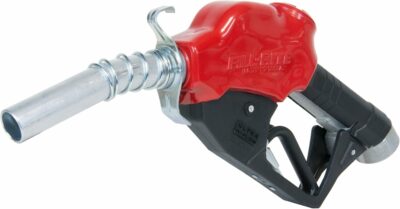
Editor’s Rating:
Design
When it comes to getting a fuel transfer pump that you can trust, it tends to be a little difficult. So many pumps on the market promise a lot more than they can deliver, which can be a little disappointing when you finally bring the pump in and it does not perform as promised in the pump specifications. That is why it feels good to find something that does the job well and that you can trust. The Fill-Rite line of pumps never fails to impress, delivering the best quality performance on the market at the best prices.
The Fill-Rite FR1614 diesel fuel transfer pump, in particular, is very good at what it does and is one of those pumps you can trust and rely on.
When it comes to durability, it comes with a durable cast iron construction. It is heavy duty iron that can handle pretty much anything levelled against it and ensures that your pump will last many years before it finally gives in.
Performance
The operation of the pump is pretty good as well. The pump is specifically designed to save you power and operate in the most efficient way possible. It will also work very fast, delivering fuel at over 50 liters per minute. That way, you don’t have to wait too long for the fuel to be transferred once you turn the pump on. You will be impressed by just how fast t works, especially when you’re fueling small vehicles, machinery, and equipment.
The hose is pretty long on this pump, making it versatile enough for a lot of applications. It also comes with a long power cord for connection to distant power sources. As for the size and weight, it is small and light weight, making it highly portable.
Pros
- Very easy to install
- Lightweight design
- Durable
Cons
- Only works for diesel
7. FuelWorks 10305708A 12V 15GPM Fuel Transfer Pump Kit
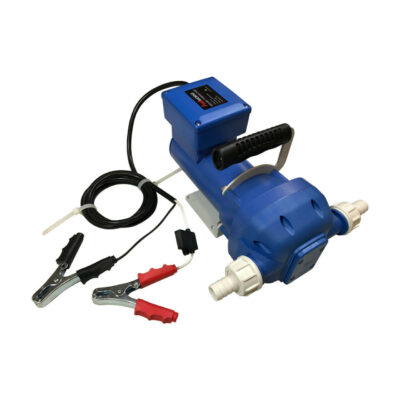
Editor’s Rating:
Design
When you talk about the FuelWorks 10305708A fuel transfer pump, there are two things that immediately become important: one is how small and lightweight the pump is, making it highly portable. The other is the fact that it very easy to install and operate.
The specs themselves are fairly common. The pump is a 12 volt pump. You should make sure you have a compatible power source before you purchase this pump in order to avoid any inconveniences in the future.
Performance
As for the flow rate, it is pretty good. Not many pumps at the price point of this one will deliver a flow rate of 15 gallons per minute. For some perspective on just how good that rate is, one gallon is approximately 3.7 liters, meaning a flow rate of 15 gallons per minute is equivalent to nearly 60 liters per minute. That is very fast service and more than enough for small and medium sized vehicles, equipment, and machinery.
Something else that is bound to impress you is the suction on the pipe. Considering the fact that the motor delivers about a quarter horsepower, it has very powerful suction, making it pretty powerful, especially against an oil as light as diesel. That’s really the only sad point about this pump; the fact that it will only work with diesel. With such great features, it would be fantastic if it could also pump oils thicker than diesel.
As for the construction, the casing on the pump isn’t cast iron, but it is fairly strong. It’s aluminum. The pump itself is fairly durable and easy to install and use. The spare parts are also readily available and easily affordable in the event that you need to replace any parts.
Pros
- Very easy to install and operate
- Has a lightweight and portable design
- Has a fast flow rate
Cons
- Only works with diesel
8. XtremePowerUS X1114
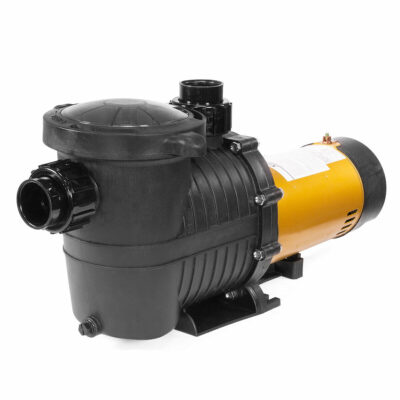
Editor’s Rating:
Design
The XtremePowerUS X1114 is one of those pumps where the name itself gives you a powerful hint of what to expect. In this case, you can expect extreme power from this pump.
The design of the pump is heavy duty and primed for safety. It has a heavy duty cast iron construction, which means it is explosion proof and will last through just about any kind of wear and tear you might expect in its normal operation. It has also been designed specifically to be mounted on tanks and barrels to make it more efficient and, of course, safe. At 32 pounds, it is fairly lightweight for a pump in its category.
Performance
Let’s start with the flow rate. The pump delivers a whopping flow rate of 30 gallons per minute. For some much needed perspective, that’s nearly 80 liters per minute. This pump obviously isn’t for your average small vehicle or light machinery and equipment. It was designed specifically for large vehicles and heavy equipment and machinery. For that purpose, however, it does its job fairly well.
When it comes to versatility, this pump is surprisingly versatile, given its price. It is capable of pumping both light and heavy oils, making it highly versatile. It will easily work with diesel, gasoline, heptane, and hexane. When you’re dealing with large vehicles, or heavy equipment and machinery, then you want a pump that is capable of pumping the different kinds of fuel that these vehicles and machinery operate on. That is why versatility is so important. Luckily, though, this pump delivers just the kind of versatility required for such heavy applications.
Pros
- It is an excellent choice for boat slips
- Has a good handle, just like the type on commercial gas pumps
- It is very powerful
Cons
- It only operates on large vehicles and heavy machinery and equipment
- It is noisy
9. Koehler Enterprises RA990

Editor’s Rating:
Design
This is a manual pump. That means it gives you quite a lot of freedom when it comes to powering and operating it. You don’t need a power source, except perhaps yourself. You can save on your power bill that way and still get to pump your fuel. On the other hand, the fact that it is a manual pump means that needs a bit of elbow grease to operate, especially in situations that require you to pump a large amount of fuel or very thick oils. That said, it’s pretty useful for the pumping of antifreeze and gas oil.
Despite its small size and manual operation, the Koehler Enterprises RA990 is great for use with multiple purposes, doing its job faithfully. If you need a small pump that you can use in your shop or garage, then this is the tool for you.
Performance
That’s really what makes this pump such a great thing to buy, Don’t think of it as a heavy duty fuel transfer pump that you will use for your vehicle, though you can use it for that as well. It is more for use with your light garage machinery and lightweight use applications.
As if none of that is enough, this pump can also be used as an air pump due to the handy adaptor it comes coupled up with. You will love the fact that it comes with a two hoses and a nozzle.
It has also been conveniently designed so you can easily take it apart and break it down into its individual components for easy storage.
Pros
- Can easily be taken apart for easy storage, making it a highly portable pump
- It is excellent for lightweight applications around your shop or garage
- It is excellent for those situations where you would rather save up on power
Cons
- It isn’t very durable
10. TeraPump TRFA01
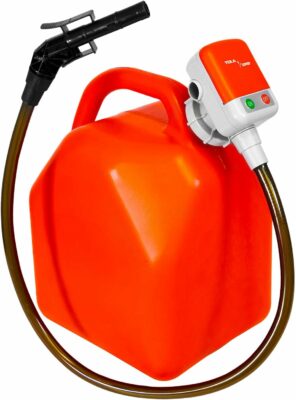
Editor’s Rating:
Design
Here is another fuel transfer pump that is perfect for regular home use.
The TeraPump TRFA01 was designed for regular filling of such things as motorbikes and lawnmowers and other such things. You will love quite a few things about this fuel transfer pump, which we though were very thoughtful additions.
To begin with, the nozzle will fit most plastic fuel cans. With a fuel transfer pump like this, you can expect to use small fuel cans quite often, and you need a fuel transfer pump nozzle that will easily fit them, making work much easier for you. That’s what you get with the TeraPump.
It also comes with 3 different sized adaptors. If you’re going to be working with things as varied as motorbikes and lawnmowers, then you want an adaptable enough pump that it can deal with the different sizes of the inlets and deliver good service nonetheless. The adaptors ensure you get exactly that, a versatile pump that will work for any small equipment and machinery you might have.
Performance
The nozzle is also a no-spill auto-stop nozzle. The last thing you want is to spill any precious fuel you’re trying to transfer. Being the valuable liquid that it is, fuel must be preserved, and the manufacturers behind this fuel transfer pump couldn’t agree with you more, hence the very thoughtful design.
Basically, this fuel transfer pump is a work horse that was made to drain your fuel source right down to the bottom when you want to transfer fuel. It works like magic, so long as you have a lightweight application for it, and it will fit into a wide range of different equipment and machinery.
Pros
- The intake hose is quite flexible
- It can lift gas to a great height
- It works perfectly for motorbikes and lawnmowers
Cons
- It wasn’t built for heavy duty applications
Guide to Buying the Best Fuel Transfer Pumps
Here we’re going to have a bit of a more in-depth look at the process of choosing a fuel transfer pump, particularly the most important factors you should consider when making your decision.
The Flow Rate of the Pump
The very first factor you should consider is the flow rate. It is basically a measure of how quickly the pump dispenses liquid, as we mentioned earlier. The flow rate that is right for you will be determined by the size of the vehicle, equipment, or machinery that you will be transferring fuel to. If the rate is too low, and you’re dealing with an especially large fuel tank, then it might take a little too long to fill the tank. If the rate is too high for the tank size, then you’ll have to deal with frothing and possibly spilling.
Power Source
Here we are looking at whether the pump will use the mains, a battery, or your own effort to operate. You should consider the specific circumstances and location in which the fuel pump will be used before you make a decision about which power source will be appropriate.
If you’re running a fuel station and have a regular supply of power, then a fuel transfer pump that runs on 110V or 230V AC power should do just fine. If you’re working in a different location, then you might want something that runs on 12V or 24V that can easily be powered by the battery in your car.
The Set Up Process and Fueling Mechanism
Will you be setting the fuel transfer pump permanently or do you want something a little portable? Will you be refueling? If you’re going to be using the fuel transfer pump at a refueling station then you’ll want something permanent that can be mounted to the floor, a wall, or the tank. If, however, you will be pumping your fuel from a portable tank, then you will want something that comes with a secure but temporary mounting kit.
Measuring Capabilities
If you’re purchasing a fuel transfer pump for commercial reasons, such as for a fueling station, then it should be able to measure the amounts it dispenses to a high degree of accuracy. That way your customers get exactly what they pay for.
Safety Features
The fuel transfer pump should also have safety features installed to protect it and the people who operate it. It should be explosion proof in the presence of explosive gases, and should be safe and easy to use.


